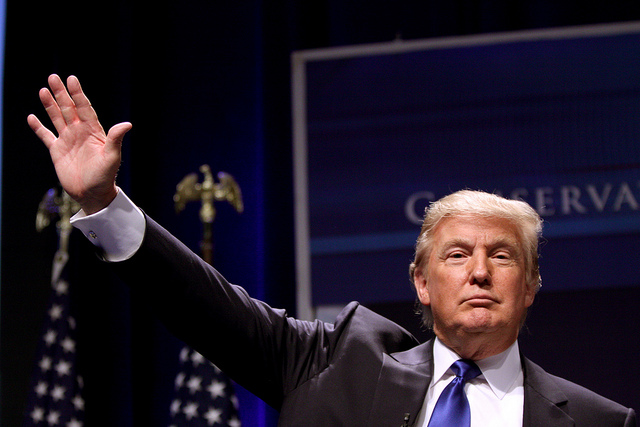
GOP Presidential candidate Donald Trump released details of his tax reform plan today. It features a system with much lower tax rates than current law, and a broadened tax base for high income earners.
“Trump’s plan is certainly consistent with the Taxpayer Protection Pledge,” said Grover Norquist, president of Americans for Tax Reform. “Trump has said he opposes net tax hikes and has made clear that the real problem is spending. This plan is a reform, not a tax hike.”
The plan is not a tax cut, but is rather intended to be revenue neutral under a dynamic score.
Basic elements of the Trump tax plan include:
Carried interest: The plan “ends the current tax treatment of carried interest for speculative partnerships that do not grow businesses or create jobs and are not risking their own capital.” Partnerships that do not speculate but rather buy hard assets for the long run will not face a tax increase – for example, private equity firms.
Private equity firms do not speculate, but rather grow businesses and create jobs. Most importantly, private equity partnerships risk their own capital, namely the capital provided by the pension funds, colleges, and charities which invest in them for long term investment returns. These types of investments are vital for workers with traditional pensions, for the colleges Americans send their children to, and for the charities they support.
The carried interest tax hike in the Trump plan is intended to only apply to the type of funds Trump has always said they would apply to: “hedge fund guys.” Americans for Tax Reform opposes any change to the tax treatment of carried interest — including those on hedge fund guys — but is pleased that the usual target of this left wing ivory tower tax hike proposal–private equity partnerships — is held harmless in the Trump plan. This is not the case, for example, in Governor Jeb Bush’s plan.
As the rest of the GOP field prepares to release their tax plans, they should keep in mind the Left’s long term goal to tax ALL capital gains as ordinary income. That’s why this carried interest tax hike idea originated in the bowels of leftist academia, and is nearly universally supported by the progressive Left — it’s the camel’s nose under the tent toward taxing all capital gains at ordinary rates. Republicans and conservatives should not give aid and comfort to this long term strategy.
ATR has detailed the case against carried interest tax hikes with op-eds in USA Today and Forbes.
Tax rates: Individual tax brackets of 0, 10, 20, and 25 percent (the top rate today is 39.6 percent). The “zero bracket” would apply to married couples’ first $50,000 of income (half that for singles).
Capital gains and dividends: By repealing Obamacare’s savings surtax, the capital gains and dividends rate is reduced from 23.8 percent today to 20 percent under the Trump plan.
It’s also important to note that with a top ordinary income tax rate of 25 percent, the carried interest tax rate hike on “hedge fund guys” is fairly modest, rising from 23.8 percent today to 25 percent under the Trump plan. ATR opposes this tax increase.
Business tax rate: The tax rate on corporate and non-corporate businesses is 15 percent, down from 35 percent today for corporations and 39.6 percent for pass-through firms.
Death Tax: Repealed.
Alternative Minimum Tax (AMT): Repealed.
Marriage Penalty: Repealed.
The plan is intended to be revenue-neutral under a dynamic analysis. In order to make up the remaining lost revenue, the plan features the following major base broadeners:
Deduction phase out: All itemized deductions except for charitable contributions and mortgage interest will be subject to a steeper means-test phaseout than they face under current law.
Deemed repatriation and an end to deferral: An immediate “deemed repatriation” tax of 10 percent is assessed on the $2.5 trillion of U.S. company profits sitting overseas. Going forward, companies would no longer be able to defer U.S. double tax on profits earned overseas.
According to the OECD, the U.S. business tax rate would fall from highest in the developed world to one of the lowest. When state rates are factored in, the U.S. would face the same tax rate as the United Kingdom, and lower tax rates than trading competitors China, Japan, Canada, Mexico, Germany, and France. We would be far below the developed nation average business marginal tax rate of 25 percent.
The loss of deferral is troubling, but two elements should be kept in mind. First, the new 15 percent tax rate is far lower than the double tax companies face today. Second, businesses will be able to credit against this 15 percent U.S. tax any foreign income tax they have already paid overseas. With one of the lowest tax rates in the developed world, it’s very unlikely much if any double taxation will, in fact, occur.
Life insurance tax shelter repealed: Life insurance will no longer be tax-advantaged for high-income taxpayers
Business interest: This deduction will face a phased in cap.
Other deductions and credits: Tax breaks for high-income taxpayers and large firms will also be eliminated, but these are not specified.
No movement to full business expensing: The most disappointing part of the Trump plan is that the tax system would move no closer to full expensing of business fixed investment. Businesses would still be saddled with the complex, distorting, and growth-inhibiting “depreciation” regime where an asset is deducted over several or even many years. Far better would be to move to a full-expensing business cash flow model, where all business inputs including investments are deducted in the year spent. While this is somewhat ameliorated by the far lower tax rates, a lack of progress here is the plan’s biggest drawback.
To hear more analysis of Donald Trump’s tax plan, listen to the latest podcast of The Grover Norquist Show here.

